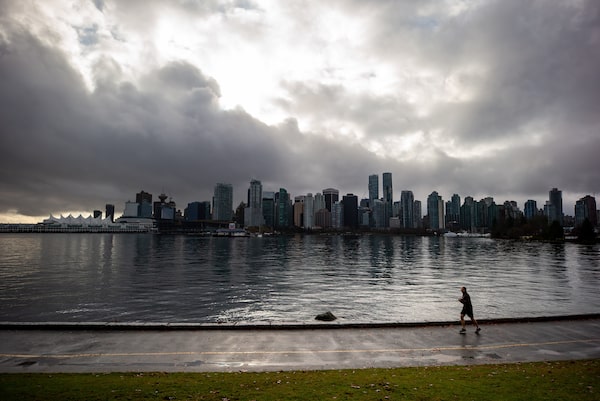
The sun begins to break through the clouds above the downtown skyline as a man runs on the seawall in Stanley Park in Vancouver on Dec. 9, 2020.DARRYL DYCK/The Canadian Press
Vancouver’s engineers and environmental specialists already know that building seawalls or dikes won’t prevent ocean water from flooding into the city as sea levels continue to rise.
And so while other coastal cities around the world start to experiment with new flood-protection methods, Vancouver, too, is looking at novel approaches.
It’s an effort that appears more urgently needed with every passing month, now that British Columbia’s climate-change events are growing increasingly severe.
Beginning this fall, Vancouver will be holding what it calls the Sea2City design challenge. Two design teams, which will be selected through a public tender, will work with city officials and residents to develop strategies that could be used around the city’s False Creek inner harbour. The teams will attempt to find ways of accommodating a 50-centimetre rise in water levels by 2050, and a two-metre rise by 2200.
The purpose of the exercise is to help the city imagine new sea-change strategies to implement at some point in the future. The new techniques are expected to be less about trying to block water with walls or other hard barriers and more about allowing the city and the rising sea to coexist.
The proposed measures could include things such as a new kind of porous seawall, or a walkway set on poles over the water, or a dike set back from the shoreline that would allow high tides to flood in at times while allowing the land to be used for recreation when the tide is low. A design solution might even involve physically moving buildings away from the shoreline.
The city’s senior sustainability specialist, Angela Danyluk, who is in charge of overseeing Vancouver’s flood-protection efforts and the Sea2City design teams, said the city needs to act before it’s too late.
“B.C. doesn’t have an answer to urban coastal flooding,” she said. “We have to dream up new ways. This is our start. What tools could exist?”
Vancouver has been planning for sea-level rise since 2012, as have many other Lower Mainland municipalities. At the start, the city considered concepts such as installing gates at the entrance to False Creek to reduce future surges.
Engineers and designers increasingly see keeping water at bay with hard barriers as futile. Even the Netherlands, a country famous for using dikes in its efforts to keep water from overtaking its below-sea-level land, has abandoned that legendary approach, according to Deborah Harford, the executive director of Simon Fraser University’s Adaptation to Climate Change Team.
Ms. Harford said many cities are now trying to find ways of controlling water that incorporate “low-carbon resilience.” That means using less concrete and more gentle and environmentally sustainable strategies.
The problem with traditional seawalls, she said, is that they create as many problems as they theoretically solve.
“If you do a seawall, the waves explode up. So the construction of a seawall requires a huge slope and that means you’re going to destroy all of the foreshore habitat.”
Surrey, B.C. is considering a barrier island on one part of its coastline. The island would break the force of incoming waves in a gentler way, Ms. Harford said.
Vancouverites have already begun to notice that seawalls don’t solve flooding. In recent years, king tides in the winter have inundated parts of local seawalls in Kitsilano, as well as West Vancouver. Last year, the waves at Stanley Park were so violent that they dumped huge piles of rock on its walkway.
The Sea2City design competition will focus on four sites near False Creek, which runs between the downtown peninsula and the rest of the city. About 38,000 people live near the areas likely to be affected by flooding as sea levels rise. There are also 200 industrial properties nearby, as well as the popular Granville Island area, BC Place Stadium, and the Cambie Bridge.
False Creek has been filled in over the past century in order to create more land in the inner city. A $2-billion new hospital, St. Paul’s, is being built on some of the fill area. It, too, will be affected by sea-level rise in coming decades, according to the city’s projections.
Each of the two design teams in the competition will come up with flood-protection strategies for two of the four False Creek project sites.
Tamsin Lyle, the founder of Ebbwater Consulting, a flood-management consultancy, will be on one of the competition’s technical advisory teams. She said she is hoping the competition will bring in international designers and introduce Vancouver to some new ideas.
“This is a wicked problem and we need to have collaborative solutions. This is our opportunity to build smart,” she said.
Vancouver, she added, has been the first major city to talk about the possibility of retreating from rising waters by removing homes or businesses from shorelines.
Surrey proposed a similar idea for Crescent Beach in 2018, but the idea was eventually abandoned because of resistance from residents there.
But some Vancouverites are starting to understand that retreat might be the only option. About a dozen residents along the Fraser River expressed some interest in expropriation or moving away when the city held consultations there.
“There’s been a noticeable shift in terms of what people are willing to consider,” Ms. Lyle said.
We have a weekly Western Canada newsletter written by our B.C. and Alberta bureau chiefs, providing a comprehensive package of the news you need to know about the region and its place in the issues facing Canada. Sign up today.
 Frances Bula
Frances Bula